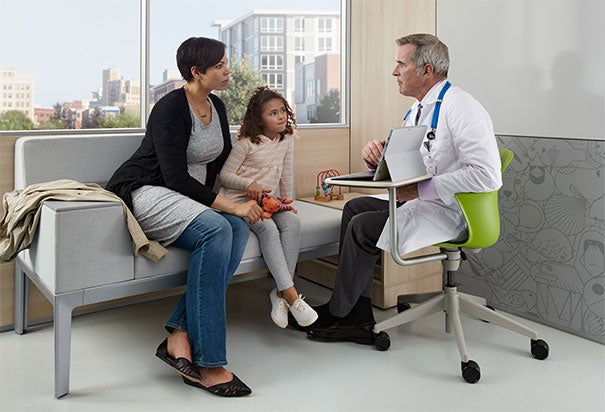Traditional exam rooms not conducive to modern care: study

Steelcase Health designed the Node with ShareSurface clinician chair to support a more participatory experience in the exam room.
New research from Steelcase Health reveals five pain points in the patient exam room, and technology seems to be at the center of each one. Electronic health records have put many physicians in a catch-22 situation. On one hand, it supports integrated care and gives patients better access to their health information. However, the charting performed by clinicians during patient exams can lead to an awkward setup and break the flow of communication.
Karen Betten, M.D., runs her private practice specializing in functional and primary care in Portage, Mich. She says that one of her biggest issues when examining patients is where to place her laptop.
“I ended up using my exam table and put it in between me and patients, which was not ideal, but it worked,” she explains. It also caused the patients to twist awkwardly while sitting on the exam table to make room for the laptop and sit face-to-face. Before starting her private practice, Betten worked in a conventional space where the computer sat against a wall, forcing her to turn her back to the patient during exams, which wasn’t any better.
In its research, Steelcase found that bad placement of technology can disrupt collaboration between patients and physicians in five distinct ways.
- Lack of eye-to-eye communication. Large, bulky computers and static furniture is often a barrier to being able to look patients in the eyes.
- Traditional postures reinforce hierarchy. Traditional exam room settings place doctors standing over patients or sitting below them, placing both parties in awkward positions. This discourages behaviors that support partnership.
- Physical barrier. Computers are often positioned for the doctor to view the screen but give poor access to information to patients and their families.
- Slow and awkward transitions. Static computers and immobile furnishings hinder the doctor’s ability to transition quickly between consultation, inputting data, sharing information, ordering labs or prescriptions and performing the physical exam
- Little ergonomic support. Computers stationed on mobile carts often force doctors stand or sit on small stools, negatively impacting their physical comfort.
“Our observations and interviews revealed that most exam rooms were not designed for the doctor-patient-family-computer interaction,” explains Caroline Kelly, principal researcher, Steelcase Workspace Futures. “They were designed for the physician to perform physical exams, minimal charting or typing on a computer and to support the presence, but not inclusion of the family. The collaboration between a patient, his or her family and the doctor greatly impacts the patient’s health and outcomes; that collaboration is built by establishing trust, sharing information and making decisions together. Right now, exam rooms do not enable that relationship. It is time to rethink the exam room experience.”
Betten has been testing a new piece of furniture that has a built-in table where she can place the laptop. It also has an armrest where patients can place their arm as she takes their blood pressure and other vitals.
“I notice I’m able to position myself better,” Betten says. “Exam rooms usually aren’t big enough, so when using my exam table the patient would be twisted around, which was not ideal. Now I can be in front of them.”
Another area that Betten wants to see improved in patient exam rooms is better positioning of family members and other caregivers. Finding a way to make large pieces of furniture movable (i.e., the exam table) is also on her wish list, along with better integration of technology. Perhaps screens can be positioned on the wall so that patients can follow along as the doctor completes charting, she says.
Michelle Ossmann, MSN, Ph.D., director of health care environments, Steelcase Health, says any changes made to patient exam rooms should focus on improving the partnership between physician and patient.
“What’s needed today is an environment that supports discussion, and teaching and learning, all characteristics conducive to partnership and patient engagement,” she says. “And when all participating parties are sharing in the care process, patients are more engaged and tend to better manage their own health, which ultimately leads to healthier people.”




